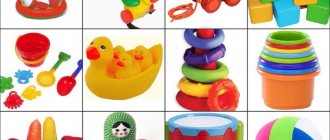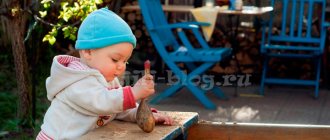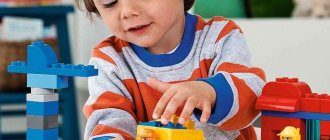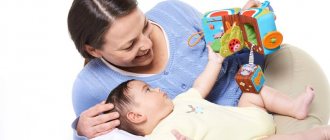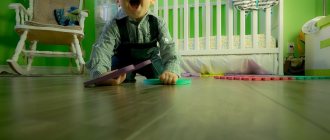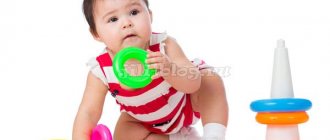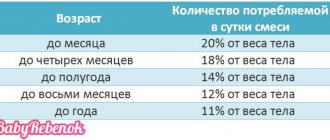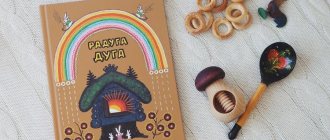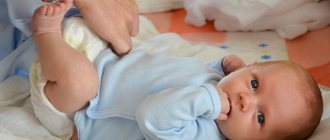A child's early development influences his ability to communicate and learn in the future. What games and toys should I choose for my baby? What skills should you focus on developing as you grow? This article will help you understand these issues.
With the arrival of a child in the family, parents are faced with a huge number of questions related to the baby’s health, proper care and development. Intuitively, every mother feels that the little person most of all needs love and constant emotional and physical contact with adults. While playing, the baby explores the world, learns to communicate and develops harmoniously.
What toys should a child choose?
The choice of toys for a child of the first year of life plays a big role. With the help of simple objects, the baby gets his first ideas about the world around him and experiences positive emotions from playing.
- Simple forms . To begin, offer your child objects of simple shapes - cubes, rings, balls. This is how the baby learns to hold various things in his hands.
- Safety and environmental friendliness . Toys must be safe and durable. Be prepared for people to throw them, try to bite them, suck them, so pay special attention to the material they are made of
- Bright colors . All toys must have clear shapes and bright colors. If this is a figurine of an animal, then it must be made with all the features inherent in this animal. For example, if this toy is a cat, it must have the outline of a muzzle, definitely eyes, paws, and a tail. Toys in bright colors will help your baby learn to distinguish colors
- Variety of textures . Choose toys made from different materials: wood, fabric, plastic, silicone can have a smooth or textured surface. This is important for the development of tactile sensations
Educational toys for children up to one year old
Toys for children under 1 year old
A baby from 0 to 12 months is actively getting to know the world around him, so you need to select toys that will give the baby a comprehensive understanding.
A good toy should be:
- light and elastic;
- without sharp corners;
- attractive (not necessarily bright for newborns);
- multi-textured (made from materials that feel different to the touch);
- no replaceable or fragile parts;
- of sufficient size so that the child cannot eat it;
- without sharp frightening sounds;
- easy to care for.
The older the baby gets, the wider the range of his toys becomes. This does not mean their quantity, but their diversity and complexity. If in the first months there are enough toys that give an idea of color, shape, sensations, sounds, then in the second half of the year there should be simple solvable tasks. For example, nesting dolls, stacked pyramids, soft cubes, etc.
You cannot give your child all the toys at once. It is best to focus his attention on one or two, replacing them after a few days to maintain interest in the games.
How to play while developing a one-month-old baby?
- Talk to your baby . Even if at first it seems to you that the child is too small and cannot understand you, constantly talk to him - while feeding, changing clothes, bathing, resting
- Observation . Take a fairly bright object or toy, hold it in front of the child at a distance of 30-40 cm. When the baby concentrates, slowly move it in a circle, from side to side, making sure that the child watches the movement. After each type of movement, leave a little time to rest
- Mom's face . Help your baby focus his eyes on your face. Move slowly - the baby will turn his head after you.
- Mom's voice . If you move around the room where your baby is, call your baby by name to get his attention. When moving to another place, raise your voice again. This develops the child's hearing and helps orientation in space
- Massage . Since the time for outdoor games has not yet come, do massage and gymnastics. Start by stroking with light movements, stretch your feet, and straighten your arms and legs. The more tactile contact the baby feels, the calmer and more comfortable he feels.
Massage and gymnastics for infants
Development of a 5 month old child in play
This month, the baby is good at catching changes in intonation and distinguishing between “friends” and “strangers” . He already has some accumulated information experience , which facilitates developmental activities from birth.
Recently you taught your baby to focus his eyes on one toy, and now he can already choose the desired item . Now you can teach your baby to manipulate objects so that he can keep himself occupied in the future.
- Encouraging crawling Place a musical top not far from the baby, to which you have to crawl. The pleasant sound and bright appearance of the toy motivate the baby to crawl.
- Pull the ribbon! Tie a ribbon or string to a bright, attractive toy. Place the toy away from the baby lying on his tummy, and give the end of the string or ribbon to his hands. Show your child how to pull the ribbon to make the toy come closer. Please note that ribbon and rope should not be left for the child to play with when you are not in the room with him!
- Hide and seek Cover the baby with a diaper, then call and open the baby's face. This way you will accustom him to your name. You can also do this with your loved ones so that the baby himself tries to call you or your friends.
How to play with a 2 month old baby?
- Smile . Don't forget to show your baby emotions. Every time you lean towards the crib, smile at the baby before holding it in your hand. Ask: “How does mom smile?” “And how does Sasha, Masha, Dasha smile...?” after a while the baby will smile back
- Bell . A two-month-old baby can turn his head while lying on his back. If you hang a bell or rattle near the crib and let the child listen to the sound several times, then he will turn his head towards this sound.
- Soft palms . While resting, take different pieces of fabric (wool, cotton, silk, fluffy fur) and rub it over your palms. This will allow the sense of touch to develop
- Short poems . Accompany your actions with funny nursery rhymes. The child pays attention to repeated sounds and the rhythm of the voice
Emotional development of the baby through communication with mother
Developmental exercises from 0 to 3 months
The first three months of a baby's life are characterized by low activity. But even for this age there are good developmental exercises that should not be neglected.
First month
No toys are required and the focus is on the parents.
Exercises with sound - approaching the child, changing diapers, washing, talking to him, changing the volume and intonation of his voice. Loud words attract attention and alarm, while quiet words, on the contrary, lull you to sleep. Call your baby by name from different distances and different corners of the room to teach him to track the direction of the sound.
Focusing on the mother - the baby must see the mother’s face and remember it. Keeping the baby's attention on you, slowly walk left and right so that the baby turns his head behind you.
Observation – Draw attention to the toy by holding it about 25 cm from the newborn and slowly moving it in different directions.
Tactile exercises – the baby’s sense of touch is best developed, so touch him often and let him touch you. Massage has a beneficial effect, but only after consultation with a specialist.
Second month
The baby perks up, which is especially noticeable when the mother approaches. Attention is already concentrated longer.
Ringing a bell – With your newborn on his stomach, ring a bell in front of him. Having become interested, the baby will turn towards this sound when the bell no longer sounds in front of him, but to the side.
Tactile activities – stroke your child’s hands and fingers with different-feeling materials to improve their sense of touch. Coarse knitwear, knitwear, fur, and silk are well suited for such exercises.
Observation - the toy moves faster than in the exercise from the first month. To do this, for example, you can tie it to an elastic band above the baby’s bed, simulating the bouncing of an interesting object.
Swimming – holding gently under the back or by the shoulders, perform the figure eight exercise. It is especially useful for problems with muscle hypertonicity.
Third month
The baby can already hold his head up, hold small objects in his hands, and look after his own hands. At this age, interest in the environment increases, so the baby makes attempts to roll over.
Exercises with a fitball (inflatable ball) - the child is placed with his stomach on the ball and slowly rocked in different directions.
Playing with rattles - the baby is on his stomach, with several different rattles in front of him at a distance. When the baby reaches for one of them, create support for his feet with your hand. This way, the baby will try to push off, which is important for crawling.
Accustoming to music - turn on a children's song, clap your hands to the beat of the music, slowly spin around in a dance.
Direction of sound - alternately hang a knitted bracelet with bells on different arms and legs of the baby. As they move, they will ring, and the baby will turn his head, looking for where the sound is coming from.
Games from the previous month can also be left, especially massage and intonation.
What games are for a 3 month old baby?
- Exercises on the ball . At the age of 3 months, the child can already lie on his tummy for a long time. Place your baby on a gymnastic ball and rock it a little - this develops spatial orientation and evokes positive emotions
- Take a toy . Invite your child to reach the toy while lying on his stomach. Don't offer many items at once, place 2-3 within reach. If you see that the baby is trying to reach with his hand, place your palms under his feet. Feeling support, the child will begin to push off. Let the child take a good look at the object, hold it in his hands and use it for its intended purpose - rattle, knock
- Let's listen to music . Play different music for your baby at a moderate volume - classical music, rhythmic melodies, children's songs. Try to make movements to the beat of the music - clap your hands, rock the child. Buy a musical toy - children especially like carousels and mobiles, when along with the music it becomes possible to follow rotating objects
Exercises on a gymnastic ball to develop coordination
Educational games up to a year by month
Educational games for a 1 month old baby (games and nursery rhymes for a newborn)
Conversation with a child. Talk to your baby constantly when you enter the room, when changing clothes or bathing him.
Change the intonation and timbre of your voice. A quiet voice will calm you down, while a loud voice will attract attention. Mom's face. When the child focuses his gaze on his mother's face, move slowly in different directions - the baby will turn his head behind you and follow you with his eyes.
Observer. Take a bright toy and move it in front of the baby’s face from side to side, in a circle, vertically. The distance from the face should be approximately 25-30 cm. When the child can follow one direction of movement with his eyes, let him rest. Then try another movement.
I hear mom. When you walk through the room where the child is lying, raise your voice and call the little one by name. When changing direction, respond every time. The baby learns to follow your movements and develops hearing.
Don't forget about massage; at this age it is no less important than educational games for a newborn. The more often you touch the child’s body (while changing clothes, feeding, bathing), the calmer and more confident the child feels and behaves.
Educational games for a 2 month old baby
Bell. At two months, the baby turns his head, lying on his stomach, hears and distinguishes sounds. After ringing the bell, hang it on one side of the crib, from above. Then, upon hearing the bell, the baby will turn his head in that direction.
Affectionate mittens. While your little one is awake, stroke his hands with different samples of fabric: knitted mittens, a silk scarf, a piece of fur. This will help develop the child’s sense of touch.
Jumper. Sew an elastic band to any soft toy and hang it over the crib. Let the toy “jump”, and the baby will follow it with interest.
Poems. It's time to start introducing the child to simple rhymes, nursery rhymes, songs and jokes. There are jokes for any action: for massage (stretchers, stretchers), for bathing (Water, water, wash my face: so that my eyes sparkle, my lips turn red, my teeth bite, my mouth smiles). The child will be happy to answer you by hooting.”
Figure swimming. Putting the child’s head on your palm, try to “move” him along the surface of the water in different directions, describing a figure eight, left and right. This educational game for a 2-month-old child will help the baby’s spatial orientation, and such an aquatic environment that is close to him will help relieve hypertonicity and simply bring pleasure.
Educational games for a 3 month old baby
Exercises on the ball. The child can already lie on his tummy for quite some time and hold his head up for some time. Place it on a large inflatable ball and rock it back and forth, gently, left and right. Orientation in space and the vestibular apparatus develop.
Take a toy. Having placed the baby on his stomach, place 2-3 bright toys in front of him and rattle them. If the little one tries to reach one of them, place your palm under the foot of the leg - when it feels support, it will try to push off. This educational game for a 3 month old baby will help him start crawling earlier.
Let's listen to music. Play different music: funny children's songs, classical, lullabies. Try to perform some actions in time with the sound (clap your hands, spin around with the child in your arms, sway, sing along).
Miracle bracelet. Place a bracelet made of knitted fabric on which bells and bells are sewn onto the baby’s arm (or leg). Developing coordination, studying your arms and legs, as well as spatial orientation will be much more interesting.
Don't forget about massage! With nursery rhymes and poems.
Educational games for a 4 month old baby
Answer me. The mother leans over the child and chants rhymes with long vowels (Petusho-o-ok, cockerel, golden comb-o-ok). This results in clear pronunciation of vowels. The child will respond by “walking.”
Give me the toy. The adult takes toys with different textures and one by one places them in the hands of the baby lying on his back. In educational games, you should pay attention to the correct grip, namely the position of the thumb. Lightly take the toy and give another. Preparation for fine motor skills takes place - tension and relaxation of the hand, various materials are studied.
Mirror. If you have toys with reflective mirror inserts, secure them to the crib. At a distance of approximately 25 cm from the child’s face. It is very interesting to look at your reflection even at this age.
Mobiles. They can be hung earlier, from 2 months. Fine motor skills, the ability to focus gaze, and tactile sensations develop. You can hang not only toys, but various household items (bottles, brushes, spoons, figurines of animals and birds).
The child is trying or already knows how to roll over onto his stomach and back. Praise him and offer him the first books with big, bright pictures.
Educational games for a 5 month old baby
Balls. Rag: with its help, grasping skills and coordination of hand and eye movements are developed. With pimples it will help develop fine motor skills. With a built-in bell - hearing development. And a little later, at 6 months, the baby can usually play with the ball on his own, lying on his stomach or sitting in his mother’s arms.
Hid. Educational game for a 5 month old baby “peek-a-boo”. The mother hides from the child behind her palms and then opens them with an exclamation of “peek-a-boo.”
Let's jump. The baby is happy to stand on his feet if you hold him. While reading a poem to him, let him squat and jump. Be sure to hold your child.
We call them toys. When holding out different toys, we clearly name them and give them to the child. Memory is trained and tactile sensations develop.
Educational games for a 6 month old baby
Buttons on toys, boxes. Opening and closing boxes and pressing buttons are usually very popular with kids at this age.
Ladushki . Classic game of palms with rhymes.
All items of interest. A period of active exploration has begun, and if it is not dangerous to health, allow the child to take and touch various objects and things. By exploring the world, we develop.
Educational games for a 7 month old baby
Bags of cereal. Small bags filled with various cereals (buckwheat, peas, beans, rice). Give them to your baby and they will help develop fine motor skills, allow exploration, and they can be grabbed, chewed, and thrown.
Hammer. A toy with squeakers at the ends. Babies as young as 7 months love to bang these toys on the floor. Fun and useful for coordination.
Drum. Any saucepan, bowl and wooden spoon are suitable for playing. The baby hits different “drums” and hears the difference in sounds. Useful for developing hearing and logic.
Books and cubes made of fabric, “rustles” will arouse interest, develop attention, and are useful for fine motor skills. Show the book to your child, then he can look at it himself.
Educational games for a baby aged 8 months
Plastic bottles with cereals or water. They can be twisted and shaken. The sound and sight of rolling grain or gurgling water stimulate the development of vision and attention.
Musical toys. Helps develop thinking and hearing. The child will understand the connection between the action and the result obtained: by pressing a button, a toy pops up or music plays.
Cubes, dishes, squeaking toys. Anything that can be dropped on the floor. Cognition and fine motor skills develop. A little later, at about 9 months, you can make this educational game a little more complicated and teach him to throw objects on purpose (a ball into a bucket, a toy into a box).
Light. If there is a table lamp, let your child turn it on and off by pressing a button or pulling the cord of a floor lamp. Voice your actions: “The light is on!” “They turned off the light!”
Third wheel. Give your child two toys. And then offer another one. An interested child must be able to free one hand to take the offered toy.
Educational games for a 9 month old baby
Bath toys. The child sits well enough and can independently bathe ducklings and ships in the bathtub. Help him - show him how toys swim and dive.
Pyramids and cubes. Simple pyramids with a small set of rings. Develops motor skills, cognition, synchronization of eye and hand actions. We teach how to build a tower using cubes and destroy “Bang!”
Matryoshka dolls develop motor skills and form the concept of size. Show your baby which figure is small and how it hides in the big one.
A box with holes for pushing toys inside. If everything has already been hidden, let the child try to open the box and find where all the toys went. Be sure to praise him.
Piggy banks. Boxes or jars with slots in which you can put small items (buttons, clothespins, balls).
Educational games for a 10 month old baby
Cars on a sustainable basis. Buy your ten-month-old baby a mobile car on wheels. Show that if you push it, it will roll across the floor. Inertia cars are perfect for such an educational game. Skating forward and backward teaches you to perform basic movements necessary for both girls and boys.
Musical toys (drum, piano). There is a development of auditory perception and coordination. It is better to play to rhymes or a song.
Designers. Simple options develop motor skills, logic, and thinking.
Rag toys or dolls with large facial features. The game will introduce the child to the names of body parts and faces. Offer to show where the doll's eyes and nose are. If your baby is unable to show, do it with him, moving his hand and pointing out the named parts of his face.
Educational games for a child aged 11 months
Gurneys. Toys on wheels that you can carry in front of you while walking (wheel, butterfly). They teach walking, balance, the concept of support and movement.
Mechanically wound toys (cars, trains, mice). Develop motor skills and logic. Invite your child to start the toy himself.
Toys with a sports bent (a rocking chair in the shape of a horse, a car that you can ride while sitting). Coordination, walking and running skills develop. This educational game for a child aged 11 months should be carried out under adult supervision. Thanks to it, the child comprehends the orientation of the body in space.
Educational games for a 12 month old baby
Cubes, balls, clothespins, drawing, modeling - all this can be safely offered to a little researcher.
Rake. Scatter small toys on the table and show how you can use a sand rake to rake everything into a pile or from the table into a box.
Boot. Invite your child to put on the shoe himself. Help him cope with this task and be sure to praise him, even if you did almost everything yourself. This is an excellent exercise for a child under one year old to develop motor skills, patience and independence.
An album with photographs of family, friends and the baby himself will occupy his attention. Recognizing faces develops memory. Just make sure that your baby doesn’t accidentally tear or crush valuable family photos.
All educational games up to one year by month for a specific age can be used later, at an older age, the main thing is the child’s interest in them. Don't forget about music and massage at any age - massage is good for health, and music develops creativity.
How to develop a child at 4 months?
- Let's exchange toys . Place a toy in your child’s hands that is interesting to him, making sure that he grips the object correctly—the position of his thumb. After a while, offer him to exchange for another thing, do not forget to smile and ask kindly. The baby will hold out the toy and take another. This exercise is aimed at developing fine motor skills, tension and relaxation of hand muscles, as well as social behavior skills.
- Hide and seek . A game of hide and seek with a child looks like this: the mother covers her face with her hands or a scarf, you can hide behind the side of the bed, and then appear with the exclamation “Peek-a-boo.” You can also “hide” a pet or toy. Don’t forget to accompany your actions with words and correct intonation: “Where is the dog hiding?” - “That’s where the dog is”
- Who's there? When dad, grandma, brother or sister enter the room, pay attention to this. “Who came to us?” The baby, being in an upright position, can distinguish people from a distance of 2-3 meters and react emotionally to them
Carousels and modules for the development of a child’s hearing, vision and attention
Playing with four month old babies
At this age, the child already loves to coo for a long time, look at his fingers and palms, and tries to roll over on his tummy. Colic has ended, so it is easier for mother and baby to explore the world around them together.
We offer the TOP 5 best developmental activities for four-month-old babies:
- Let's party together. The mother leans over the toddler and tells him a poem, trying to stretch out the vowel sounds. For example, “Cock-o-o-ok, cockerel, golden comb-o-o-ok.” The baby, having heard the drawn-out sounds, hums in response just as willingly.
- Give it back. Parents select objects with different textures and place them in their children's hands one by one. The child will examine the toy, after 10 minutes (maybe a little less) it is taken away and the next one is placed. This exercise wonderfully improves motor skills - it tenses and relaxes your hands.
- Mirror. Suitable for four month olds and fun with a mirror. Attach the mirror insert to the sides of the bed approximately 30 centimeters from the child's face. Don’t worry, a child up to one year old can look in a mirror, especially since he will definitely like this exercise.
- Mobile. Little ones like this fun even at this age. You can purchase toys that are more complex in color and texture, or make a pendant yourself. Play helps develop fine motor skills, visual concentration and sense of touch.
- Hide and seek. A favorite game for kids, the rules are extremely simple. Mommy closes her or her baby’s eyes, hides behind the crib or covers her head with a blanket and looks out, saying “Aw” or “Peek-a-boo.” The kids are absolutely delighted with this entertainment.
From four months old, a child can buy soft books, including for bathing in the bath.
How to develop a child with play at 5 months?
- Let's jump . At the age of five months, the child loves to stand on his legs if he is held. Holding your baby by the arms, let him squat and jump, be sure to say a rhyme or nursery rhyme
- Offer your baby the first books with large, bright pictures. Show objects, animals, plants, talk about what he sees. If there are people or some animals in the picture, name parts of the face and body - “These are the eyes,” “These are the nose,” “These are the ears.” Show the same thing on the child’s face at the same time - this will arouse the baby’s interest and smile
- Develop tactile perception - let's hold objects with different shapes and surfaces - smooth and pimply balls, cubes, soft toys with different fillings - rice, rustling. Very tightly sew various buttons, beads, laces to dense fabric and let your child study
A button rug helps develop the sense of touch.
How to play with a 6 month old baby?
- By 6 months, the child begins to distinguish individual words. When you walk around the apartment with your baby in your arms, show and name objects . Start with those in which the child has shown interest, then gradually expand the list of familiar words. Bring the child to the window, show trees, clouds, birds. Pronounce each name separately and clearly
- Let's talk to mom . When the baby pronounces the syllables: ga, gu, ma, ba, etc., repeat them after the baby in a chant manner. Children immediately react to such communication - they begin to actively walk, extend their arms and smile. Such games develop hearing and initial conversational functions.
- The child becomes interested in play mats and functional toys - with buttons, sounds, pockets, and opening windows.
- From 6 months, regularly perform finger exercises . Start by massaging your fingers and palms, then use rhymes and nursery rhymes. Over time, the child himself will repeat the movements with his fingers.
Finger exercises to stimulate the development of fine motor skills
What toys should a baby have?
Toys should be made from materials that will remain safe for your baby even if they end up in his mouth (which he will).
Namely: high-quality plastic, wood, rubber. The toy should not fall apart after a day or two of play; it should be durable.
If psychologists recommend decorating a children's room in pastel colors, then toys, on the contrary, should, as they say, “catch” the eye. It’s good if your baby’s first toys are primary (not mixed) colors: blue, yellow, red, green. The child’s organ of vision is designed in such a way that it is these that he first begins to distinguish.
A mobile above your head, other pendants, a rattle in your hand: you shouldn’t be zealous in presenting all the toys at once. This will only make the baby overexcited; there will be little benefit from such entertainment, and even the opposite. We show two or three toys; we show new ones only after four or five days. The baby is no longer interested in them. After again, five days, you can again take out the rattles shown first from the chest. They will be received with a bang, like new. This rule, by the way, also applies to much older children. It is not necessary to constantly buy toys in order to have something to occupy the child; it is enough to divide the toys into two parts and hide them out of sight for a while so that they again become dear to the baby’s heart.
I got a little distracted, oh well. So, what are toys for a child before his first birthday? Firstly, with their help, the baby develops vision, hearing and receives tactile sensations. Secondly, thanks to toys, the child hones the movements of his arms and legs and develops coordination. Thirdly, he learns what shape, color, and size are. Of course, when a baby sees a ball, the words “round” will not flash through his head, no, but if the child is fleetingly told this additional information about all the objects that are in the house, on the street, etc., then by the age of one year you will distinguish a square cube from a round ball.
Games for a 7 month old baby
- Show me . Ask the child to show an object or toy that is nearby - “Show the ball.” First, take a short break and show yourself. Gradually, the pauses need to be increased; soon the baby himself will stretch out his hand to the named thing. Using the same principle, you should train your child’s ability to perform simple actions.
- Pay attention to the development of fine motor skills - prepare bags for your baby filled with different cereals and seeds - rice, buckwheat, peas, beans, sunflower seeds, which can be touched, shaken, thrown. Make sure the bags are strong and tightly tied
- Give your child soft books or wooden toys in the shape of a book that he can look at independently while turning the pages. Often such books contain inserts made of different materials that are pleasant to touch
Soft books develop tactile and color perception
How to play with an 8 month old baby?
- At 8 months of age, babies enjoy putting things in and out of boxes . Place rattles, balls, cubes, small soft toys, toy vegetables and fruits in a box or basket and invite the baby to take them out one by one. Be sure to name the objects out loud: “Yellow ball”, “Green car”, “Red apple”, etc. Ask your child to get a certain object, be sure to praise his work
- The baby will also be interested in playing with dishes - folding pots, spoons, plastic glasses, cups. Prepare colorful lids for the game - from jars of baby food, jam, juices. Folding and rearranging such objects can keep a child occupied for a long time, and also develops fine motor skills.
- Fill plastic bottles (volume 0.3 -0.5 l) with various cereals, pebbles, sand, water so that 2/3 of the empty space remains. While turning the bottles over, the child will watch the rolling grains and gurgling water. This is good for stimulating the development of vision and concentration.
- Do not leave your baby alone during games - study with him, talk, praise him for his success. Communication with adults is very important for the formation of social skills and psycho-emotional development of children
Playing with objects helps to distinguish colors, shapes, sizes
Games for a child from 10 to 12 months
It is necessary to pay special attention to the child’s walking, teaching him to navigate by objects. All previous exercises or part of them remain.
Tenth month
Toys on wheels teach the baby to evaluate the result, associating it with the efforts that were made. For example, if you pushed the car hard, it went fast and far; if you pushed it weakly, it stopped quickly.
Large construction set - develops fine and gross motor skills, thinking, intelligence and imagination.
Dolls with large facial features - from them children learn about the location of human body parts. You need to show and ask where the doll’s nose, eyes, lips, hands, and so on are.
We learn to draw - first mother draws, showing that a pencil, pen, paints, felt-tip pen leave marks on the paper. To prevent your child from painting the entire apartment, you can build a special large canvas for drawing, for example, by purchasing several sheets of A2 format.
From 10 months the child understands social hierarchy. The baby determines who is more important by size, highlighting the largest person or the largest object with special attention.
Eleventh month
At 11 months the child is already actively walking. Physical activity should be encouraged, as should interest in everything new. If a child does something wrong, there is no point in scolding him and taking him away; it is much better to show by example what and how to do correctly.
Rolling toys - this may look like a completely ridiculous toy, for example, a wheel on a stick, but these things help improve walking skills, maintain balance, develop coordination of movements and at the same time look at everything around.
Swings and rocking horses improve the vestibular system. In short, so that the child does not get seasick in the future.
Sandbox - Easter cakes, pouring sand from bucket to bucket - this is the same motor skills plus help in mastering cutlery.
Twelfth month
A one-year-old child’s view of games and things in general changes, so it is recommended to show previously familiar objects and exercises in a new light.
At 12 months, developmental activities are more creative, for example, finger paints, modeling from plasticine or salt dough. We are not talking about figures; it is enough to knead plasticine or dough, working on motor skills.
At this age, children can already distinguish primary colors, so they should begin to learn their names. To do this, take an object, a toy, and the child must choose an item of the same color from other objects. Successful attempts are actively encouraged with praise and intonation.
Another useful exercise is to pour beans and peas into a small bowl, mix and show the child that the beans need to be placed in one container and the peas in another. Do not leave your baby alone with this activity; the objects are too small, he can swallow them or stick them in his nose.
How to play while developing a 9 month old baby?
- Let's play in the water . At the age of 9 months, almost all babies sit confidently. Bathing can usually be turned into a fun game. Place boats, ducklings, and 2 small plastic cups in the bath. Show your child how boats float, how ducklings dive, pour water from one cup to another
- Cubes and pyramids . First, stand in towers of cubes, praise the child for his efforts, and do not forget to name the colors of the objects. The first simple pyramids with a small set of rings are also quite suitable for children of this age; they well develop the ability to compare objects
- Matryoshka dolls, sets of glasses folding one into the other. Show your baby how a small object is hidden inside a large one. Start with 3 items, when the child learns to arrange them, gradually increase the number of items
- Box with holes in the shape of shapes . You can buy such a toy or make it yourself. Show your baby how the figure disappears in the box, open it together, and see where the toys are hidden. After some time, children learn to find a suitable hole themselves and then take out the figures
Educational toys for children after 6 months
Useful activities for up to a year
Educational games for children under one year old are important not only for babies, but also for their parents. The baby will get used to it faster and begin to explain his desires, and communication with him will become more interesting.
Note! Games for a one-month-old baby involve communicating with loved ones. You need to talk a lot with the baby, change intonation, timbre, tickle and hug the baby.
When a child begins to be interested in objects, after 3-4 months, it is worth showing him all the diversity and introducing him to different sounds. He must understand the connection between actions, for example, if you press a switch, the lights in the room will go out. When communicating, pronounce words clearly, especially when the baby begins to babble. Fine motor skills are important at any age; they stimulate speech and develop thinking.
There are many educational toys that your baby will love and benefit from:
- remove beads, buttons from sand or play dough;
- catch objects from a basin of water with a net;
- insert the balls into the slots or remove them from the adhesive tape.
Such activities are relevant for children 6-9 months old. Closer to the year, sports games are important, for example, crawling under a stick or inside a rag pipe, climbing into a box.
What to play with a 10 month old baby?
- First puzzles . Most often you can find large wooden puzzles on sale, where you just need to insert a picture of the desired shape or assemble a picture of 4-6 parts
- You can also buy kits that allow you to choose and customize the clothes and facial expressions of the depicted character. Such games are good for developing vision and the ability to compare sizes and colors.
- The first designers using a small number of large parts perfectly develop spatial thinking, logic, and fine motor skills
- Show parts of the face and body . Ask your child to point to the nose, eyes, hands, hair on the toy, and then on mom and herself. Help your baby first; very quickly he will learn to do it on his own.
The first puzzles for the development of thinking and logic
Games for 11 month old baby
- catch-up ” allows you to develop the ability to orient yourself in space If your baby is actively crawling, show that you want to catch up with him. “Who crawls so fast?” - “I’ll catch up, I’ll catch up!” You can walk or also get on all fours. Having caught up with the baby, hug and kiss, and then let him “run away” again.
- At this age, many children take their first steps, so it is important to help your baby develop balance and coordination. Toys that you can sit on (rocking horse, rubber donkey, car) are good for this Such games should only be played under adult supervision
- Rolling toys on wheels - cars, butterflies, caterpillars on a stick, which you can roll in front of you during a walk, well develop the concept of movement, support, and teach walking
Rolling toys help the baby take his first steps
Fun for the development of 11-month-old babies
11-month-old toddlers are already walking quite actively, so it is necessary to stimulate this skill in every possible way. We offer the TOP 5 best entertainment for developing movement skills for babies under one year old.
- Gurneys. To improve balance and learn to walk, special devices on wheels that roll in front of you will be useful.
- Rocking chairs. The most popular option is the rocking horse game. This entertainment helps develop coordination of actions and improves the vestibular apparatus. However, leaving the baby alone with this device is strictly prohibited. By the way, such toys are relevant up to three years.
- Fun in the sandbox. Eleven-month-old babies love to play in the sandbox, but this is only possible in the warm season. In winter, you can purchase special kinetic sand, which also helps improve finger motor skills.
- Fishing. Try tying small trinkets to long strings and securing the strings to a chair. Demonstrate how you can pull out a “catch”. Believe me, children's delight will be guaranteed when the little one pulls out his favorite toy.
- Telephone. Construct a kind of tube from thick paper, and one bell will need to be leaned against the child’s ear, and you will speak in the second. Then invite the baby to say a few words.
By the age of one, the child continues to be interested in the same toys that remain relevant at this age: nesting dolls, pyramids and folding containers.
Educational games for one-year-old children
- It's time for creative activities - start drawing . It’s too early to give your child pencils and paints, so you can start with finger paints, a sponge dipped in watercolor paint (honey), and crayons. Take a large sheet of paper, guide your baby's hand, drawing simple shapes, name what he sees, change colors. Then let your imagination run wild
- Modeling perfectly develops fine motor skills . Prepare salt dough - it is completely safe, even if the baby tries to put it in his mouth, or buy a special plastic mass of different colors. Make balls, plates, flagella together. Show your child how to roll out sausages and cut them with a plastic knife
- Choose a color . One-year-old children can already distinguish colors quite well. Prepare toys of different colors and shapes, ask your child to separate toys of a certain color and put them, for example, in a box. A variant of the game could be “ show the same ”. Show your child a blue cube and ask him to find the same one among other toys. Be sure to praise your child and tell him if something is difficult
Drawing and modeling develop children's imagination, thinking and fine motor skills
- Educational games for young children are not like school activities. They should not be carried out according to a schedule, but according to the mood and desire of the baby. You cannot force a child to do something if it does not arouse his interest.
- Give up this activity, try to return to it later. Pay attention to emotional contact with your child. Playing with an irritated, tired mother will not bring joy and the desired effect
- Smile at your baby, hug him, praise him, show him how important his success is to you. Even without understanding speech, children perfectly sense their mother’s mood and react sensitively to it.
Useful toys for children
Useful toys for children are not bright and flashy cartoon characters, but those that help them develop. Pediatricians advise purchasing cubes, sorters, and lacing for your baby. The dolls will help him recognize the parts of the body; they can be dressed, bathed, and put to bed.
Pyramids develop logic and motor skills. They exist not only with rings, but also come in square shapes, with different bases, and in the form of caps. The latter can be nested into each other, build a tower, if turned upside down, used in games with water and sand. It is believed that the more pyramids a child has, the better. Balls and balls are also irreplaceable toys. At first the kids touch them, then they start pushing them, and then they understand that they can be thrown into gates or hoops.
Baby playing with balls
Popular are busy boards and educational toys for children, which contain many interesting elements:
- locks;
- doors;
- light bulbs;
- buttons;
- wheels;
- elastic bands;
- lacing.
Games for children under one year old are an integral part of their development from birth. Time passes quickly and cheerfully. Activities bring pleasure not only to the baby, but also to the parents, it helps to get closer, establish contact and establish mutual understanding.
